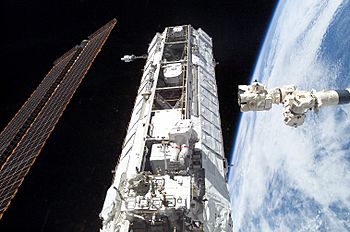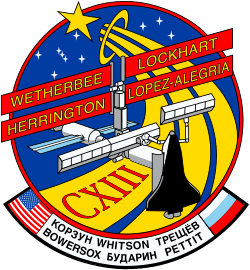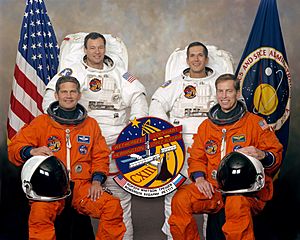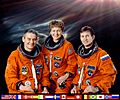STS-113 facts for kids

Lopez-Alegria climbs the newly-installed P1 truss during the mission's second EVA
|
|
| Mission type | ISS assembly Crew rotation |
|---|---|
| Operator | NASA |
| Mission duration | 13 days, 18 hours, 48 minutes, 38 seconds |
| Distance travelled | 9,000,000 kilometres (5,600,000 mi) |
| Spacecraft properties | |
| Spacecraft | Space Shuttle Endeavour |
| Launch mass | 116,460 kilograms (256,750 lb) |
| Landing mass | 91,498 kilograms (201,719 lb) |
| Payload mass | 12,477 kilograms (27,507 lb) |
| Crew | |
| Crew size | 7 |
| Members |
|
| Launching |
|
| Landing |
|
| Start of mission | |
| Launch date | 24 November 2002, 00:49:47 UTC |
| Launch site | Kennedy LC-39A |
| End of mission | |
| Landing date | 7 December 2002, 19:38:25 UTC |
| Landing site | Kennedy SLF Runway 33 |
| Orbital parameters | |
| Reference system | Geocentric |
| Regime | Low Earth |
| Perigee | 379 kilometres (235 mi) |
| Apogee | 397 kilometres (247 mi) |
| Inclination | 51.6 degrees |
| Period | 92.3 min |
| Docking with ISS | |
| Docking port | PMA-2 (Destiny forward) |
| Docking date | 25 November 2002, 21:59 UTC |
| Undocking date | 2 December 2002, 20:50 UTC |
| Time docked | 6 days, 22 hours, 51 minutes |
  (L-R): Paul S. Lockhart, Michael E. López-Alegría, John B. Herrington, and James D. Wetherbee |
|
STS-113 was a Space Shuttle mission to the International Space Station (ISS) flown by Space Shuttle Endeavour. During the 14-day mission in late 2002, Endeavour and its crew extended the ISS backbone with the P1 truss and exchanged the Expedition 5 and Expedition 6 crews aboard the station. With Commander Jim Wetherbee and Pilot Paul Lockhart at the controls, Endeavour docked with the station on 25 November 2002 to begin seven days of station assembly, spacewalks and crew and equipment transfers. This was the last flight of Endeavour before entering its Orbiter Major Modification period until STS-118 in 2007 which include modernizing the cockpit, and also the last shuttle mission before the Columbia disaster.
Crew
| Position | Launching Astronaut | Landing Astronaut |
|---|---|---|
| Commander | James D. Wetherbee Sixth and last spaceflight |
|
| Pilot | Paul S. Lockhart Second and last spaceflight |
|
| Mission Specialist 1 | Michael López-Alegría Third spaceflight |
|
| Mission Specialist 2 | John B. Herrington Only spaceflight |
|
| Mission Specialist 3 | Kenneth D. Bowersox Expedition 6 Fifth and last spaceflight ISS Commander |
Valery G. Korzun, RKA Expedition 5 Second and last spaceflight ISS Commander/Soyuz Commander |
| Mission Specialist 4 | Nikolai M. Budarin, RKA Expedition 6 Third and last spaceflight ISS Flight Engineer/Soyuz Commander |
Peggy A. Whitson Expedition 5 First spaceflight ISS Flight Engineer |
| Mission Specialist 5 | Donald R. Pettit Expedition 6 First spaceflight ISS Flight Engineer |
Sergei Y. Treshchov, RKA Expedition 5 Only spaceflight ISS Flight Engineer |
Mission highlights
STS-113 was an Assembly Mission (11A) to the International Space Station, delivering the P1 Truss segment, which provides structural support for the Space Station radiators. Mission Specialists John Herrington and Michael López-Alegría performed three spacewalks to activate and outfit the P1. The STS-113 crew and both Expedition crews transferred about 1,969 kilograms (4,340 pounds) of cargo between the shuttle and station.
STS-113 delivered the Expedition 6 crew to the station for a four-month increment. The Expedition 5 crew returned to Earth aboard STS-113, ending a 185-day stay in space.
STS-113 came to a close when Endeavour glided in to a landing at Kennedy Space Center on 7 December. It was the 19th flight of Endeavour, the 112th shuttle mission, and the 16th shuttle mission to the station. The landing was the first (and only) time a mission ended on the fourth day of landing attempts.
Also carried aboard STS-113 was the Micro-Electromechanical System (MEMS) based Pico Satellite Inspector (MEPSI). This payload deployed two small satellites which are connected via a 15 metres (49 ft) tether.
STS-113 was the last successful mission before STS-107. Gus Loria was originally scheduled to fly as the pilot for this mission, but was replaced due to an injury. His replacement was Paul S. Lockhart. John Herrington, a member of the Chickasaw Nation, became the first enrolled member of a Native American tribe to fly in space.
STS-113 was the final mission during which Russian cosmonauts flew on the Space Shuttle.
Because Endeavour entered its Orbiter Major Modification period after the Columbia disaster, this was the last shuttle mission to fly with an analog-style cockpit.
| Attempt | Planned | Result | Turnaround | Reason | Decision point | Weather go (%) | Notes |
|---|---|---|---|---|---|---|---|
| 1 | 11 Nov 2002, 12:58:40 am | scrubbed | — | technical | 10 Nov 2002, 9:00 pm | 90% | problems with an oxygen system in the orbiter's midbody |
| 2 | 22 Nov 2002, 8:15:30 pm | scrubbed | 11 days, 19 hours, 17 minutes | weather | 22 Nov 2002, 8:05 pm | 90% | weather at TAL sites Zaragoza and Moron, Spain |
| 3 | 23 Nov 2002, 7:49:47 pm | success | 0 days, 23 hours, 34 minutes | 95% | initial weather reports for TAL sites was not favorable but cleared in time for launch. |
Mission parameters
Docking with ISS
- Docked: 25 November 2002, 21:59:00 UTC
- Undocked: 2 December 2002, 20:50:00 UTC
- Time Docked: 6 days, 22 h, 51 min, 00 s
Spacewalks
| Mission | Spacewalkers | Start – UTC | End – UTC | Duration | Mission | |
|---|---|---|---|---|---|---|
| 47. | STS-113 EVA 1 |
Michael López-Alegría John Herrington |
26 November 2002 19:49 |
27 November 2002 02:34 |
6 h, 45 min | Install P1 truss |
| 48. | STS-113 EVA 2 |
Michael López-Alegría John Herrington |
28 November 2002 18:36 |
29 November 2002 00:46 |
6 h, 10 min | Install TV cameras, move CETA |
| 49. | STS-113 EVA 3 |
Michael López-Alegría John Herrington |
30 November 2002 19:25 |
1 December 2002 02:25 |
7 h, 00 min | Inspect Mobile Transporter |
Gallery
-
Landed Expedition 5 crew
L-R: Valery G. Korzun, Peggy Whitson, and Sergei Y. Treshchev
See also
 In Spanish: STS-113 para niños
In Spanish: STS-113 para niños






